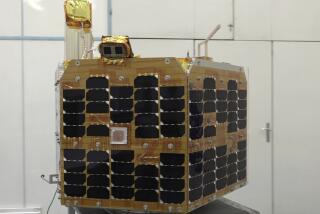Soviets Admit Satellite Will Fall, Claim It Will Be Safe
- Share via
MOSCOW — The Soviet Union admitted today that a nuclear-powered spy satellite launched in December will plunge to Earth within four months but said steps will be taken to ensure that its radioactive parts are no danger to man or the environment.
The official Tass press agency said all radio contact with the Cosmos 1900 satellite was lost in April.
Soviet space officials are continuing to monitor its deteriorating orbit but without radio contact and officials on the ground have no control over the satellite, Tass said.
“The artificial Earth satellite Cosmos 1900 with a nuclear power plant on board was launched Dec. 12, 1987,” Tass said.
” . . . The satellite will fly in orbit until August-September, 1988, after which it will cease to exist. The satellite Cosmos 1900 has systems ensuring radiation safety on completion of the flight.”
‘All Is Under Control’
The Tass announcement followed comments Wednesday by a British Defense Ministry spokesman who said that his government is tracking the satellite and that due to its deteriorating orbit 160 miles above the Earth, there is a chance that Cosmos 1900 might crash to Earth in two to three months.
Today, a spokesman for the Soviet commercial space agency Glavkosmos said Cosmos 1900 presents no danger.
“The situation has stabilized and all is under control now,” the spokesman said.
Western experts have said they fear that Cosmos 1900, a spy satellite that tracks Western ships at sea, may break apart as it falls back to Earth, possibly spreading radioactive debris from its 100-pound nuclear reactor over populated areas.
The atomic reactor supplies power to a massive radar system used to track sea traffic, often for military purposes.
Debris Spread in Canada
In 1978, the nuclear-powered Soviet satellite Cosmos 951 fell from orbit, unexpectedly spreading radioactive debris over a large section of northern Canada.
Western space experts said they believe that such nuclear-powered Soviet satellites have a built-in “fail-safe” system that boosts the nuclear power plant into a higher orbit where it drifts for decades before finally disintegrating.
Should that system somehow fail, the reactor section may break apart from the main satellite body and burn up on re-entry into Earth’s atmosphere, they said.
But if the reactor section fails to separate, the experts said, there is a good chance that the reactor will survive the intense heat of re-entry and present a potential danger to man and the environment.
More to Read
Sign up for Essential California
The most important California stories and recommendations in your inbox every morning.
You may occasionally receive promotional content from the Los Angeles Times.













